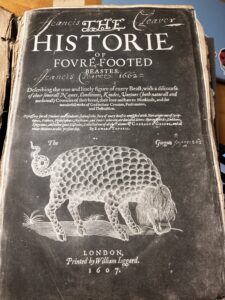
Figure 1: title page with the “Gorgon” vingette. As my copy of Beastes is missing its original title page, this is a scanned copy.
While I understand that history is not divided into inflexible periods, what struck me about Edward Topsell’s The Historie of Fovre-Footed Beastes, printed by William Jaggard in 1607, is that it seemed so anachronistic; I did not expect a bestiary, an anecdotal treatise that is, in my mind, characteristically ‘Medieval,’ to have been created in the early seventeenth century. At once, this made me reconsider the text and its context.
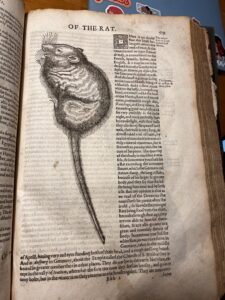
Figure 2: Topsell’s entry on the “Rat.” Note the detailed crosshatching, skin folds, and hair in this accurate depiction of a rat.
Beastes seems caught in this awkward period between eras––Reformation and Enlightenment––when scientific inquiry began supplanting the old dogmas of scholasticism and divine revelation. Like Medieval bestiaries, this codex is a compendium of factual and fantastical creatures with not only physical description of each but accompanying Christian symbology that explains them. In contrast to earlier texts, Beastes displays a subtle hint of the systematism I associated with later periods of bookmaking: it includes a catalog of every author known to Topsell who has written about animals, an epilogue, and an index of Latin and English animal names––all of which were comparatively new to the codex at the turn of the seventeenth century. Moreover, like Conrad Gessner’s Historia Animalium, from which Topsell drew almost all of his material, Beastes displays an interest in classifying the natural world with precise description in an easily accessible form intended for broader audiences. In the prefatory materials, an epistle from the collected works of Conrad Gessner, two introductions by Gessner and Topsell, contains its stated purpose: to inform, amuse, and above all to enlighten, for animals themselves are instructive, pleasing, and divine.
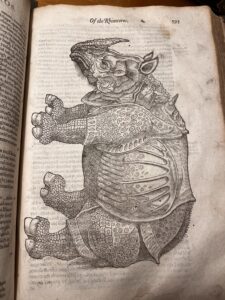
Figure 3: you might note that this print of “Rhinoceros” is stylistically different from the other prints, that is because this is actually a reproduction of Albrecht Dürer’s print of the same name
This early-modern juxtaposition between natural philosophy and natural theology is intriguing. However, my primary reason for choosing this book is, perhaps, less academic; what sealed the deal was the title’s vignette, “The Gorgon”: a creature that appears to be a scaled bull with pig trotters, a cow’s nose, and a woman’s mop of hair (Figure 1). How absurd is that? I would say that’s not what a Gorgon looks like, snake-haired and all, but then I’ve never actually seen one for myself, have I?
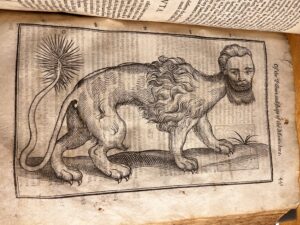
Figure 4: the “Mantichora”
These woodblock prints are an incredible feature of this codex; it is replete with them––large and small, of animals, real and imagined, from the benign to the frightful: animals familiar to seventeenth-century England like rats or cats are represented with considerable accuracy (Figure 2 & 5); creatures less familiar to the Continent, like the rhinoceros, are armored in a literal sense, clad in what appears to be fluted plate mail and lamellar (Figure 3); others still, like the “Mantichora,” with its toothy grin that hangs from either ear, considers the reader with a hungry look (Figure 4). Doubtless, it would have been expensive to produce so many prints in a single book.
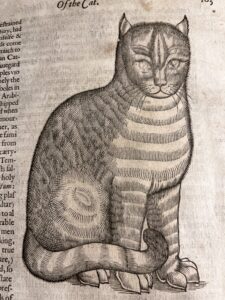
Figure 5: the “Cat”
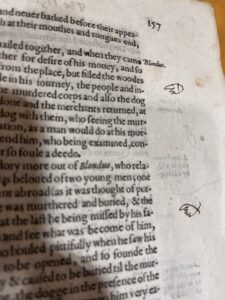
Figure 6: manicules
It would seem that past students also enjoyed this book as much as I have. Beastes has the many signs of frequent use––and misuse. The buildup of residual hand oil, indicated by smooth and darkened areas at the foot corners, suggests frequent use. In parts of the book, the damage seems intentional: in the section enumerating the various virtues and vices of the “Cat,” a reader has scratched away the eyes of the accompanying print (Figure 5), perhaps wary of the beguiling gaze which Topsell suggests; other entries, like that on the dromedary, given the cleanness of the tear, seem to have been ripped out of the book entirely!––a souvenir, perhaps? Or did one reader have a particular dislike for humped, desert-going mammalians? There are other examples of readers’ engagement with the book. Marginalia and annotation abound: I have found manicules, underlining, and margin notes throughout the book, signs that the readers sought to highlight information in the text for its later use (Figure 6). In other places, humorously, I found the bored and uneven, graphite scribblings of an uncooperative pupil, perhaps a more contemporary one (Figures 7). Indeed, it seems readers consulted Beastes often; however, these same readers were not, perhaps to Topsell’s chagrin, all that precious about this book.
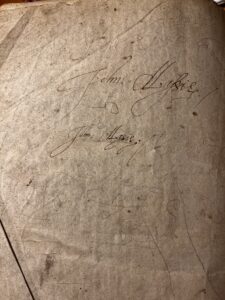
Figure 7: you can just make out the graphite scribblings on the back endpaper here. Note also that someone, perhaps a former proprietor of this book, signed this book. This will no doubt proove useful when I investigate this book’s afterlife in the following posts.
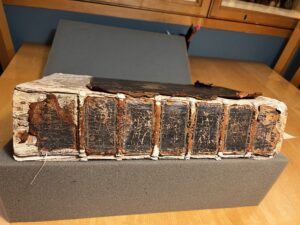
Figure 8: the spine and raised cords
At seven-hundred and ninety pages, twelve and a half inches long, eight inches wide, and two and a half inches deep, Topsell’s tome is a heavy and unyielding thing and in decidedly poor condition. The eight raised cords along the spine are nearly fully exposed, and only one remains attached to the front board (Figure 8). The somewhat flimsy pasteboards, covered in cracked caf’s skin, have all but separated from their hinges and joints (Figure 9). The endpapers have peeled away, revealing two equally spaced incisions along the outer edges of either board through which green ribbon appears to have been threaded (Figure 10). Perhaps because of the binding’s disrepair, the front matter is similarly damaged. The overall make of the book’s rag paper feels good––fine and smooth––but very thin, so much so that the printed ink bleeds through the pages, and many pages throughout are torn and crumpled.
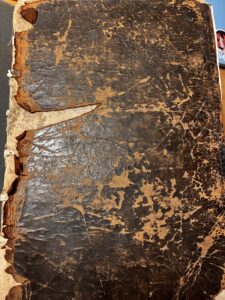
Figure 9: the cover
I do not believe these were original features of this codex and am certain that it was rebound at least once. In The Historie of Fovre-Footed Beastes, the outer margins are one and three-quarter inches whereas the gutter margins are only one inch; in A Historie of Serpents, the outer margins are two inches, the gutter margins, one inch. This irregularity in formatting indicates that the pages were perhaps cropped to facilitate a rebinding. However, it is also possible the outer margins were deliberately made larger to accommodate the printed marginalia. Notwithstanding this, as discussed above, Topsell compiled and published Beastes and its front matter in 1607; he published Serpents the following year in 1608. Topsell’s introductory notes do not mention Serpents which indicates that, even if Beastes was not rebound to include the later text, if it were, say, taken to a binder only after the publication of the later text the following year, it was not Topsell’s initial intent to compile them. It is also possible that this book was one of those volumes produced in 1658; however, as there is no original front matter, this is something I cannot corroborate.
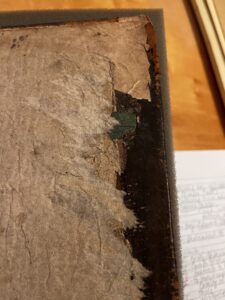
Figure 10: paste board
What is most striking about the binding is that it is not striking; even in its diminished state, it hosts no ornamentation, no embossing, no gold tooling, no marbling or mottled treatment––nothing. Why would such spartan binding enclose this no doubt expensive and decorative codex? Well, Topsell aimed not simply to impress but to inform and educate, and his audience, scholars, naturalists, aspirant zoologists, autodidacts, and students, likely valued content over aesthetics, facts over embellishment––decorative embellishments, that is, for as we probably know now, there is no such thing as a Gorgon.
Leave a Reply